The Best Aleppo Pepper Substitute (+ More Alternatives)
Want to know more about Aleppo pepper? You’ve come to the right place! We look at what they are, how they’re made, and what they taste like in our search for the best Aleppo pepper substitute.
If you own any Middle Eastern cookbooks, you’ve likely come across Aleppo pepper in the ingredient list. These sun-dried pepper flakes have a moderate heat with a sweet, fruity flavour, an earthy, almost smoky finish and a touch of savouriness.
But, unfortunately, Aleppo pepper can be tricky to track down.
Luckily, once you get to know the different types of Turkish chilli flakes (pul biber) and understand the flavours of Aleppo pepper flakes, you will easily find a suitable Aleppo pepper substitute hiding in your pantry. Or jump straight to the recipe to create a homemade Aleppo-style pepper blend at home.
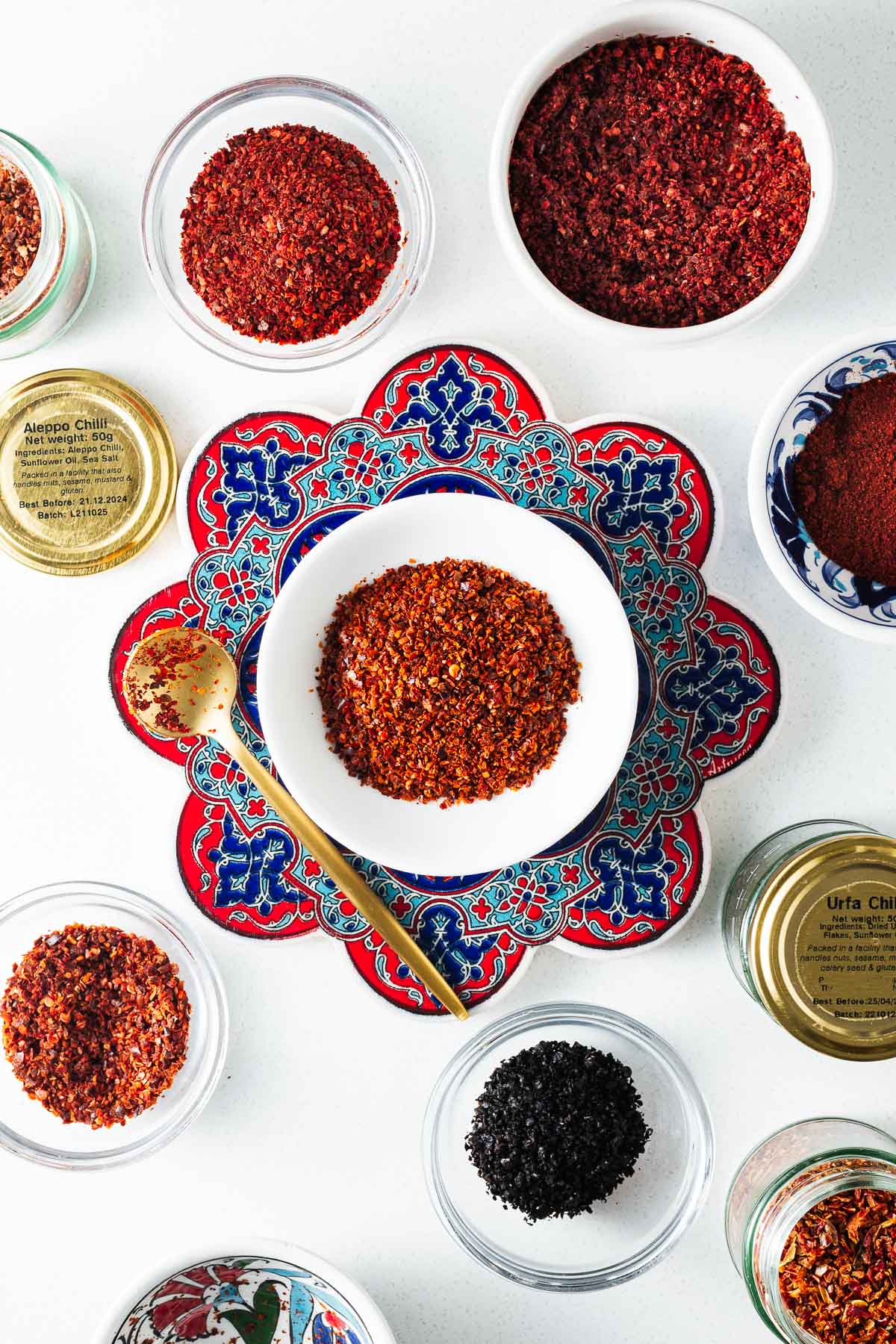
What is Aleppo pepper?
The Aleppo pepper, also known as a Halaby pepper, is a variety of chilli pepper (more about Capsicum annuum on Wikipedia) named after the Syrian city of Aleppo. But due to the ongoing Syrian civil war, Turkey is the leading producer of Aleppo pepper flakes.
Recipes most often refer to Aleppo peppers in their dried form (which is what this post is also about).
It crushed peppers have a deep red colour and a moderate heat level. The Aleppo pepper typically measures 10,000 Scoville Heat Units (SHU) on the Scoville scale. For reference, this is spicier than jalapeño peppers (4,000 to 8,500 SHU) yet milder than cayenne peppers (30,000 to 50,000 SHU).
The flavour of Aleppo pepper is more complex than many dried chile peppers. It has a fruity flavour with an earthly and somewhat smoky undertone. And it is great for finishing dishes with its beautiful red flecks.
Aleppo pepper is common in Turkish, Middle Eastern, and Mediterranean cuisine. It features in dishes like hummus, salads, kebabs, and falafel.
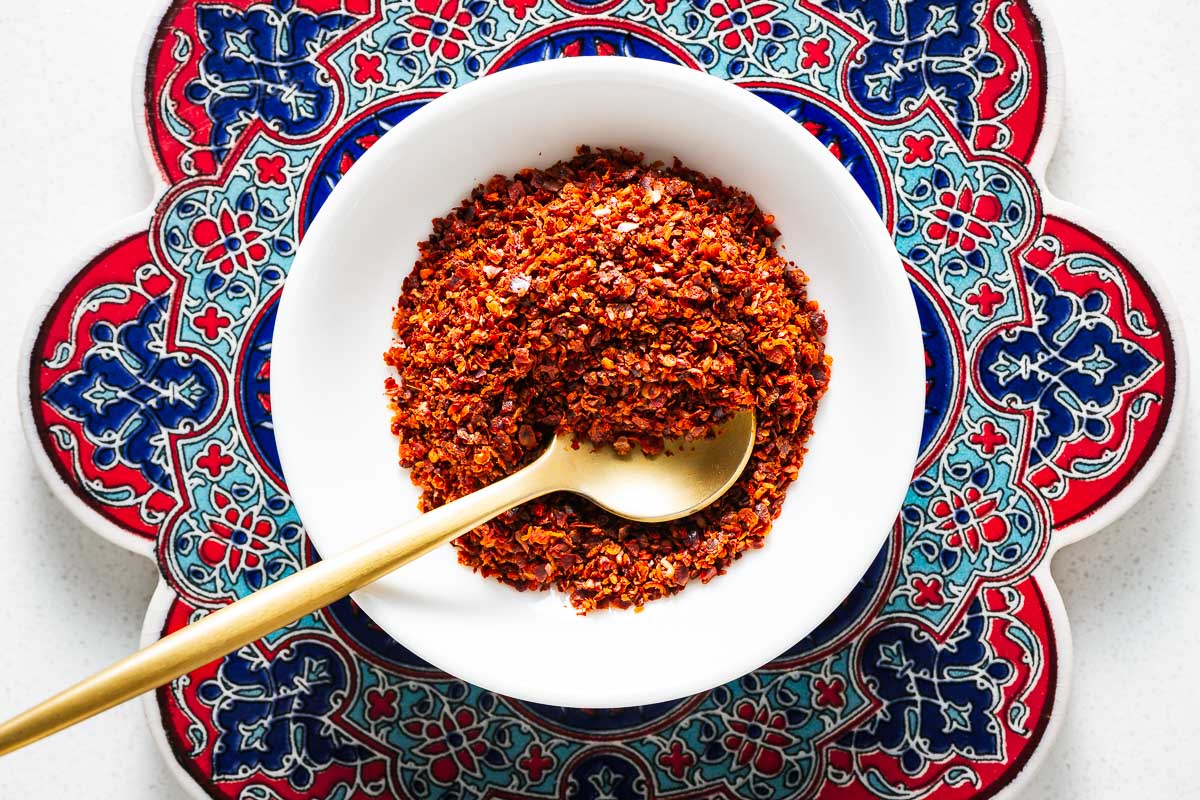
What makes Aleppo pepper special?
Aside from the uniquely mild and fruity flavour of the fresh Aleppo pepper, the technique for making Aleppo pepper flakes adds to its sweet, earthy, lightly smoky flavour profile.
To make Aleppo pepper flakes: The deep burgundy ripened peppers get semi-dried in the sun, then deseeded. Only the flesh of the peppers gets crushed into the characteristic coarse flakes. The resulting flavour is reminiscent of sun-dried tomatoes with some heat.
The final step is to coat the dried pepper flakes in oil and add a sprinkling of salt. This process enhances the deep colour, fruity flavour, and savouriness.
It also makes them utterly irresistible to sprinkle on just about anything.
Pul biber vs Aleppo pepper
Pul biber refers to Turkish red pepper flakes (pul = flake, biber = pepper). Producers sun-dry, deseed, and crush the peppers into coarse flakes, usually mixing them with oil and salt before packaging.
People often refer to Aleppo pepper as pul biber, but it’s only one type of pul biber that uses Aleppo pepper.
The most popular types of Turkish pul biber are Aleppo pepper, Urfa biber, and Maras biber (pronounced mah-rash).
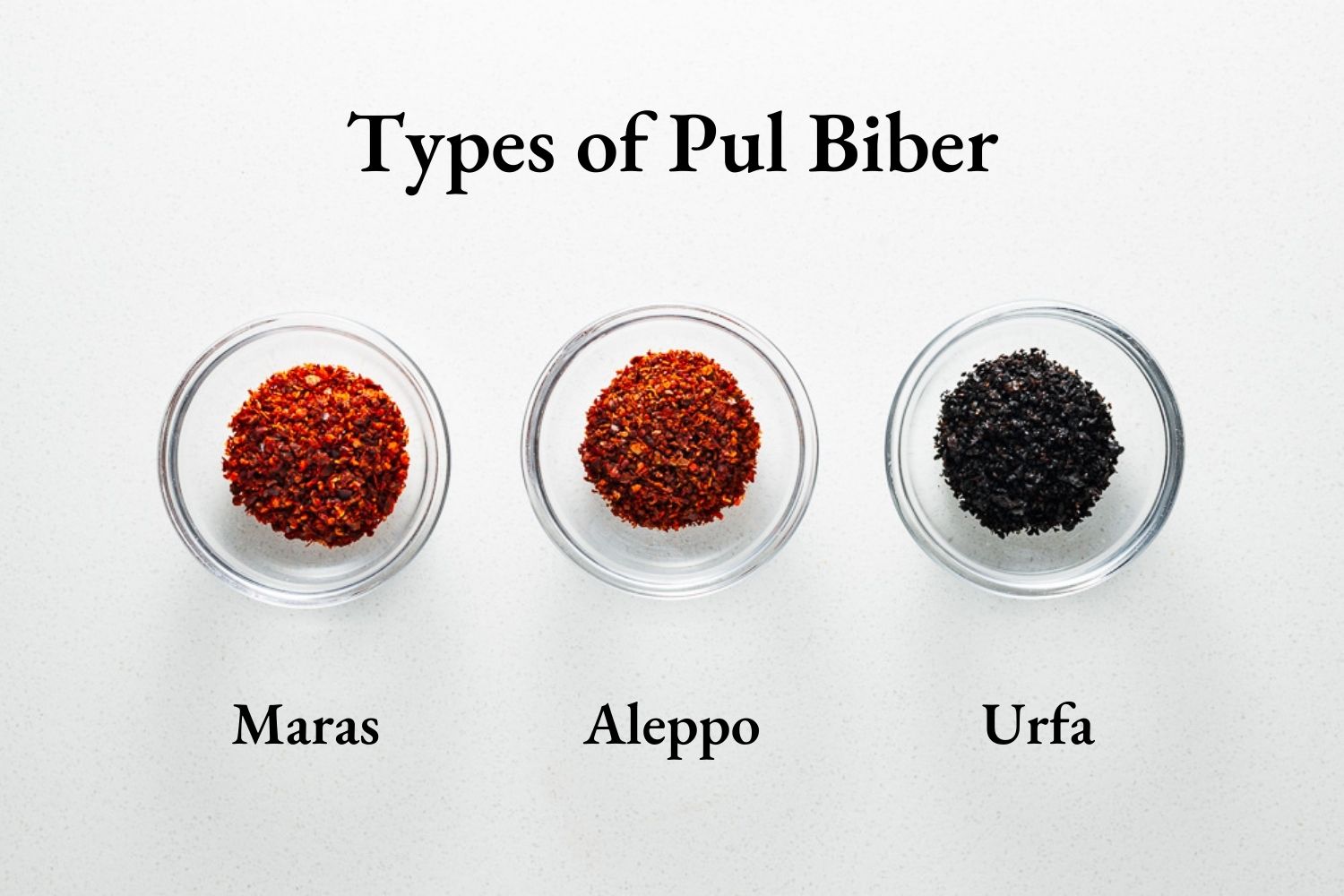
The best substitutes for Aleppo pepper
To find the best Aleppo pepper substitutes, we should understand what Aleppo pul biber tastes and looks like:
- It is moderately spicy (measuring 10,000 SHU on the Scoville heat scale).
- The flavour is fruity, earthy and slightly smoky.
- A pul biber spice mixture also contains oil and salt.
- And the coarsely ground pepper flakes are seedless.
The best Aleppo pepper substitutes should also have some of these characteristics. Let’s look at Aleppo pepper alternatives:
1. Homemade Aleppo pepper substitute
Aleppo pepper flakes are coarse seedless flakes with a deep red colour. The flavour is fruity yet earthy and moderately spicy with a touch of savouriness.
Knowing this, we can create an Aleppo-style pepper blend at home.
Ingredients for the best homemade Aleppo pepper substitute:
- Korean gochugaru flakes (or another coarse seedless chilli flake) form the base of our Aleppo-style pepper flakes.
- Smoked paprika adds a hint of smokiness.
- Ground cumin adds earthiness – you only need a tiny pinch.
- Finely ground salt (like kosher or sea salt) adds that Aleppo pepper savouriness.
- Sunflower oil (or another neutral-tasting oil) brings out the colour, softens the flakes, and allows the salt to cling to the crushed pepper.
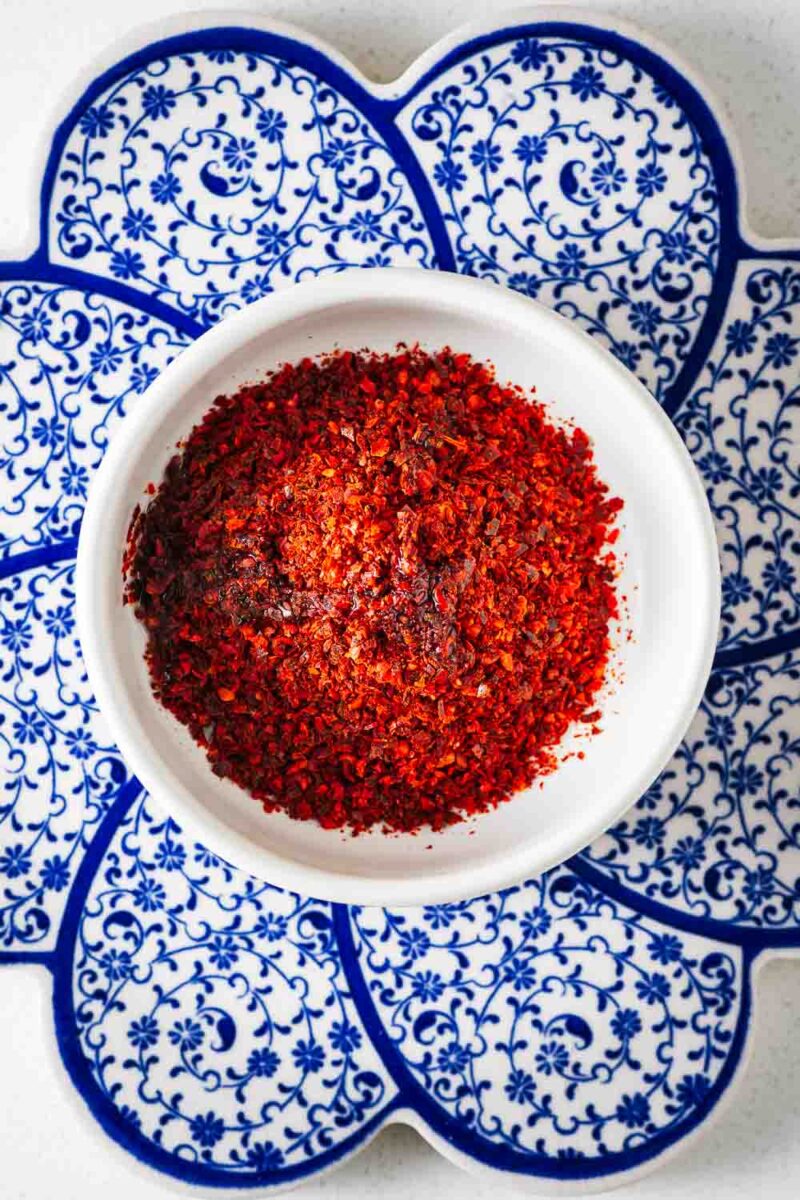
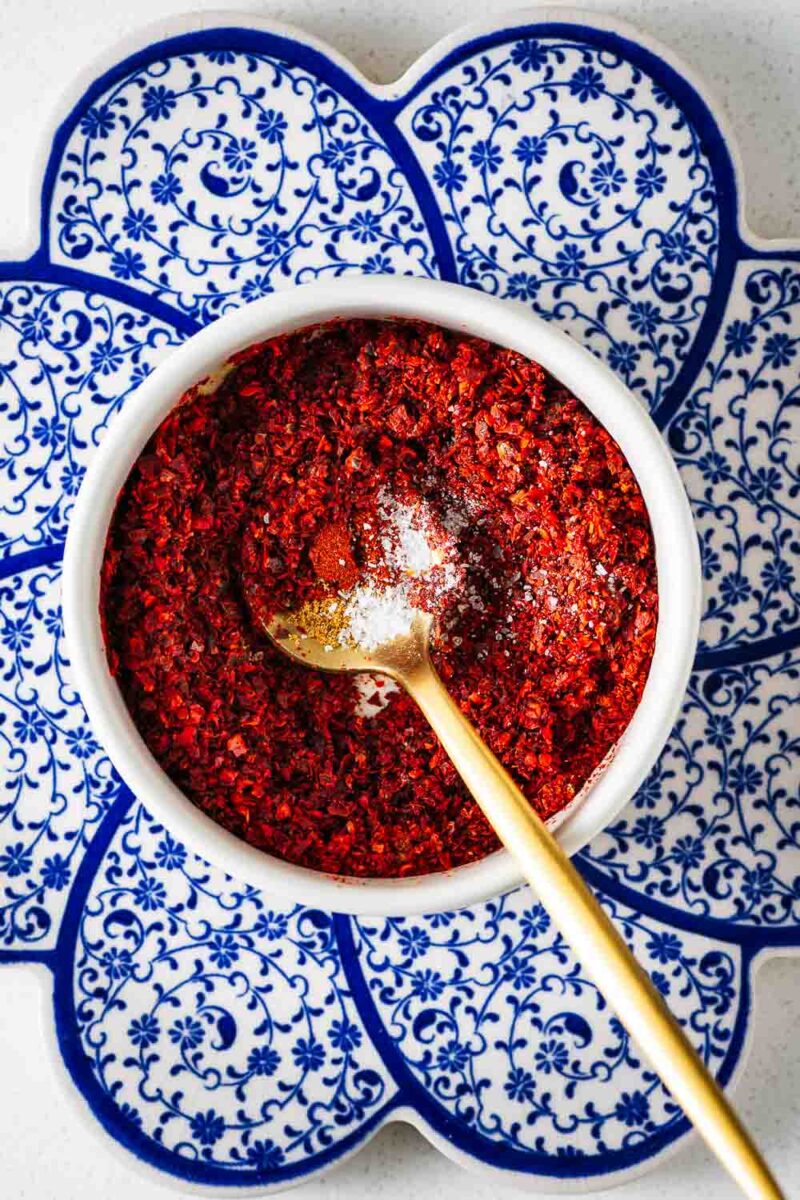
Step 1: Mix the oil into the chilli flake base.
Step 2: Add the spices and salt to adjust the flavour profile.
You can also use another type of chilli flake and adjust the spices. For example, if you use smoky chipotle flakes, you should omit the smoked paprika. And if your chilli flakes are very mild, add a pinch of cayenne pepper powder.
Or you can make chilli flakes from dried whole chillies. Mexican guajillo chile works very well to match the moderate heat and fruity flavours of Aleppo pepper.
See the Aleppo pepper substitute recipe for suggested measurements.
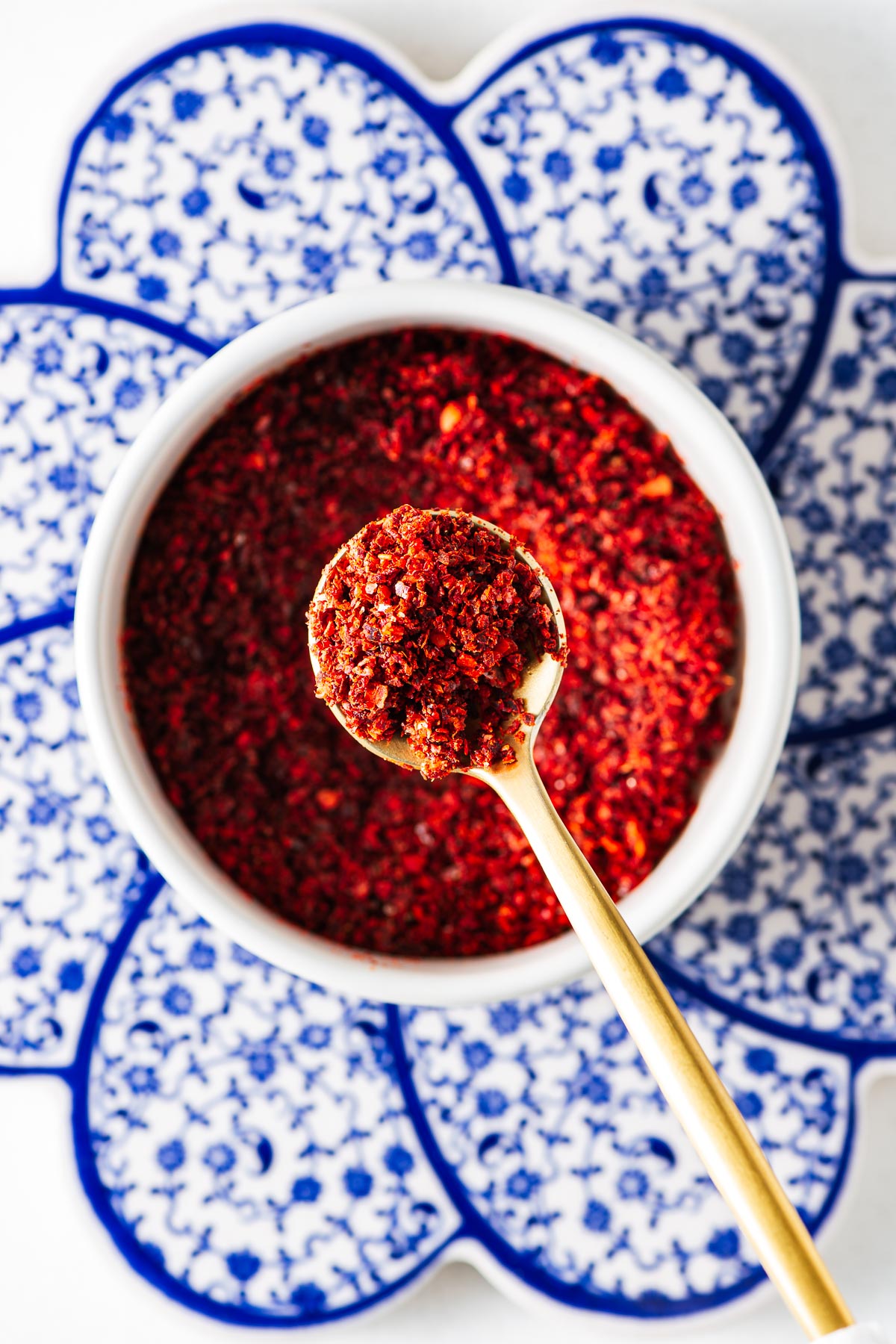
2. Turkish Marash pepper: The best shop-bought alternative
Marash pepper (or maras biber) is also a Turkish red pepper. And Marash pepper flakes, made from sun-dried Marash peppers crushed into seedless flakes, make the best shop-bought alternative to Aleppo pepper.
It is slightly milder at 4,000 to 8,000 SHU. And a touch more smoky. But in most dishes, you will hardly tell the difference.
Look for large bags of maras pul biber at Turkish grocery stores.
Use maras biber as a direct substitute for Aleppo pepper in any dish.
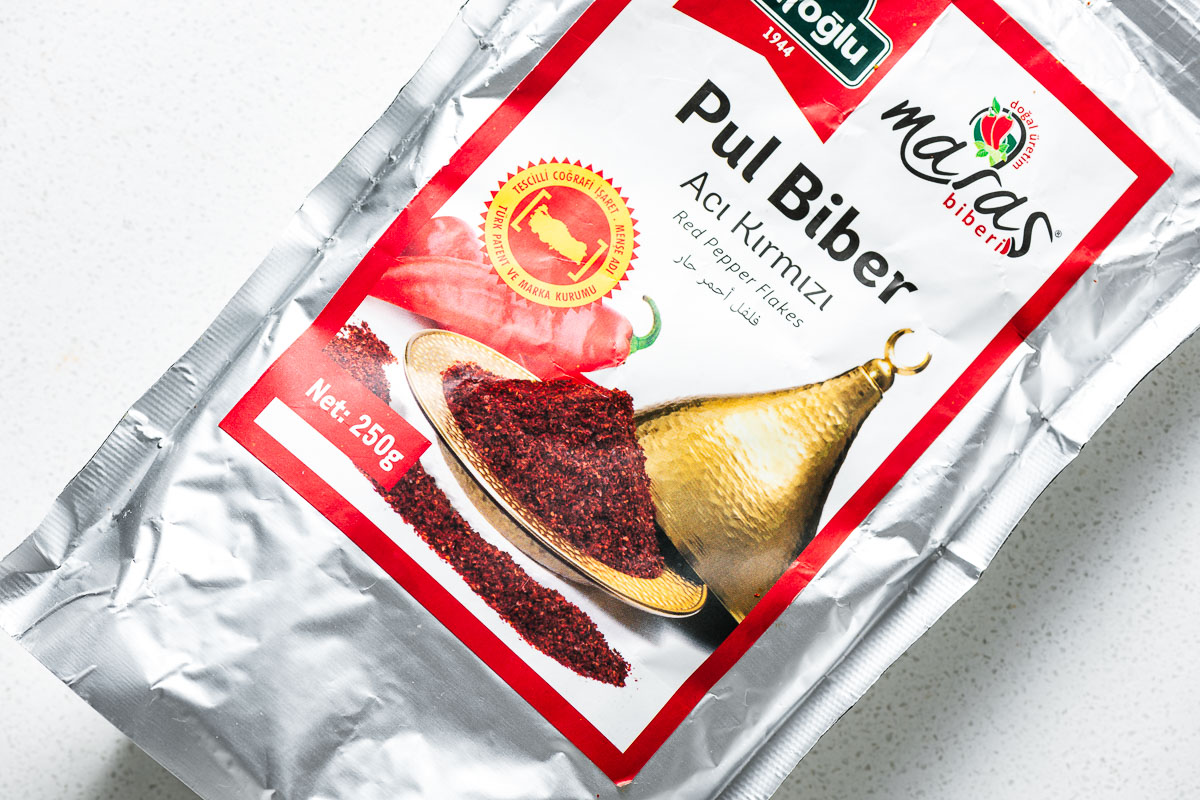
3. Antebi peppers
Antebi peppers are another form of Turkish pul biber. It is considered milder and fruiter than Aleppo pepper and Marash pepper. Though I could not find a reliable source for its Scoville heat units.
It makes a great alternative to Aleppo pepper. But if you struggle to find Aleppo pepper, Antebi biber may prove even more elusive.
Use it as a direct substitute for Aleppo pepper in any recipe.
4. Korean gochugaru
Korean gochugaru is an excellent substitute for Aleppo pepper. The dried chilli peppers get crushed into a coarse powder with a very similar texture to Aleppo pepper flakes.
The flavour is smoky and sweet. But the spice level varies depending on the type of chilli pepper used. The Cheongyang chilli pepper (10,000 SHU) makes a spicy gochugaru that matches Aleppo pepper flakes. But if you have a mild gochugaru (1,500 SHU), add a pinch of cayenne pepper to boost the heat.
If you can, look for taeyangcho gochugaru. The sun-dried Korean peppers make a great Aleppo pepper substitute.
Learn more about gochugaru and how to use it.
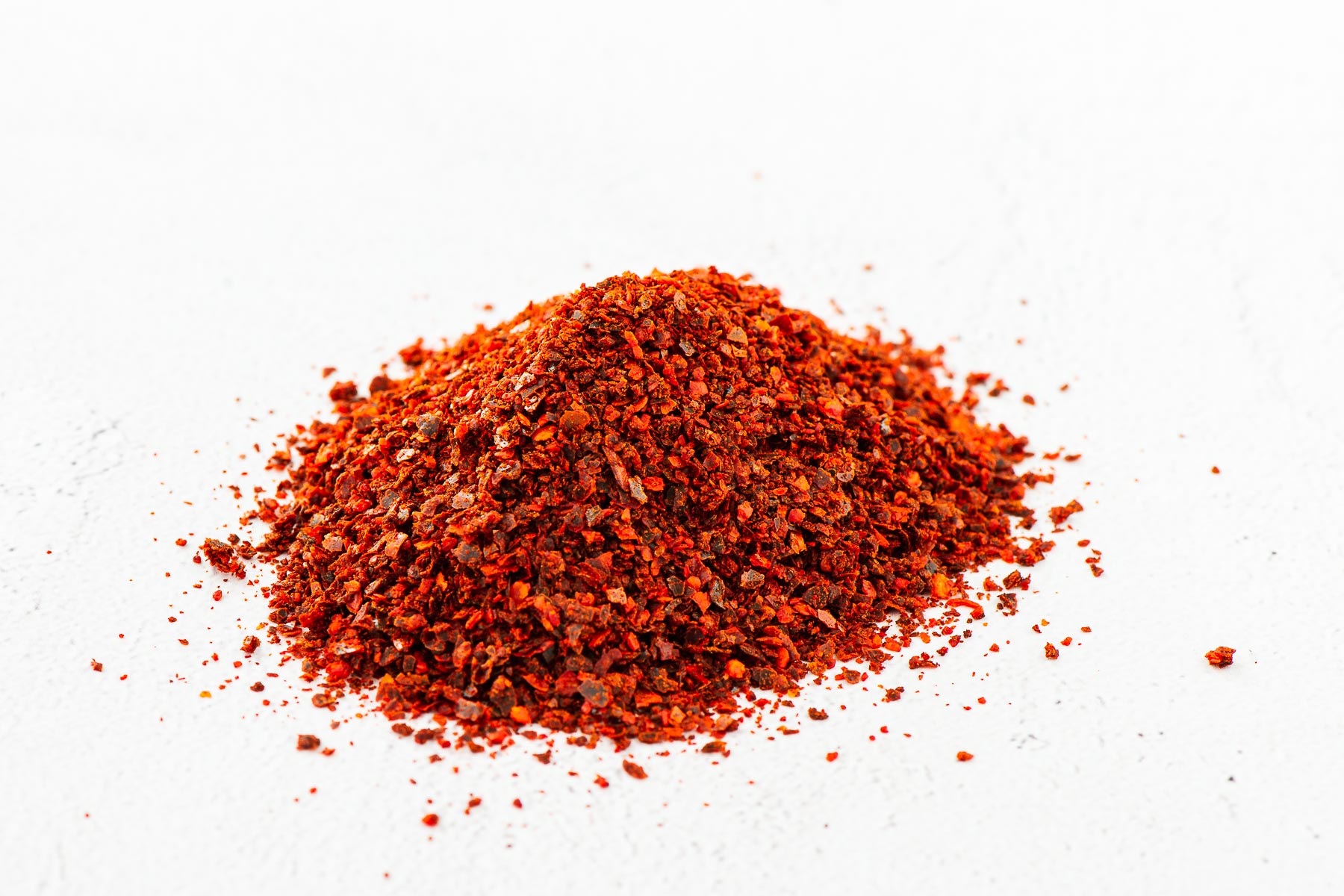
5. Ancho chile powder
Ancho chile powder (or ancho chili powder) is a mild, smoky-sweet chilli powder made from ancho peppers. The ancho peppers are actually dried poblano peppers. And they’re a common ingredient in Mexican cuisine.
The ancho pepper is mild (at 1,000 to 1,500 SHU). And it makes a good substitute for Aleppo pepper if you want something with less heat.
You can make your own Ancho chilli powder by deseeding and blitzing dried Ancho peppers into a coarse powder.
Use ancho chile powder as a direct substitute for Aleppo pepper. Or add a pinch of cayenne pepper if you want more heat.
6. Chile de árbol
Chile de árbol (Spanish for tree chilli) is a small yet potent chilli pepper. It is another common ingredient in Mexican cuisine.
This chile is significantly hotter (15,000 to 30,000 SHU) than Aleppo pepper. But it has a delicious earthy and smoky flavour. And toasting the chilli amplifies its smoky taste.
To use dried chile de árbol as a substitute for Aleppo pepper: Start by removing the stems and seeds. Then grind the dried chile flesh into a coarse powder using a spice grinder.
Use half a teaspoon of chile de árbol powder to substitute a teaspoon of Aleppo pepper flakes.
7. Paprika
Paprika is a fine red pepper powder consisting of various types of ground chilli peppers. The spice varies from bright red to brown, sweet to smoky, and mild to hot.
Regular paprika does not pack much heat.

Hungarian paprika uses a blend of peppers to create different paprika classifications. While they differ in potency and sweetness, all Hungarian paprikas have some degree of rich, sweet red pepper flavour.
Spanish paprika is often less intense than its Hungarian counterpart and ranges from dulce (mild and sweet paprika) to agridulce (bittersweet and medium hot paprika) to picante (hot paprika).
And smoked paprika (like pimentón de La Vera) is intensely smoky and earthy – significantly smokier than Aleppo.
You can use paprika as a replacement for Aleppo pepper in hummus, dips and marinades. The flavour won’t quite match that of Aleppo, but it’s a delicious Aleppo pepper alternative.
If your paprika is very mild, add a pinch of cayenne pepper to boost the heat. The Kitchn has a great article about the different types of paprika if you want to learn more.
8. Chipotle powder
Chipotle powder is a great substitute for Aleppo pepper, as both are smoky and only moderately hot. The chipotle pepper (dried smoked jalapeños) measures between 2,500 and 8,000 SHU. And the chile powder has a deep, smoky flavour – more so than Aleppo pepper.
Use chipotle powder as a 1:1 substitute for Aleppo pepper for an extra-smoky twist on your recipe.
But you can always adjust the amount to taste. Add chipotle powder to all kinds of dishes, from sauces to marinades to stews to add a smoky kick to your favourite recipes.
9. Cayenne pepper
Cayenne pepper is a hot pepper – significantly hotter than Aleppo pepper. It typically measures between 30,000 and 50,000 SHU. If you can taste past the heat, you will find that cayenne pepper is sweet, slightly fruity and a bit smoky.
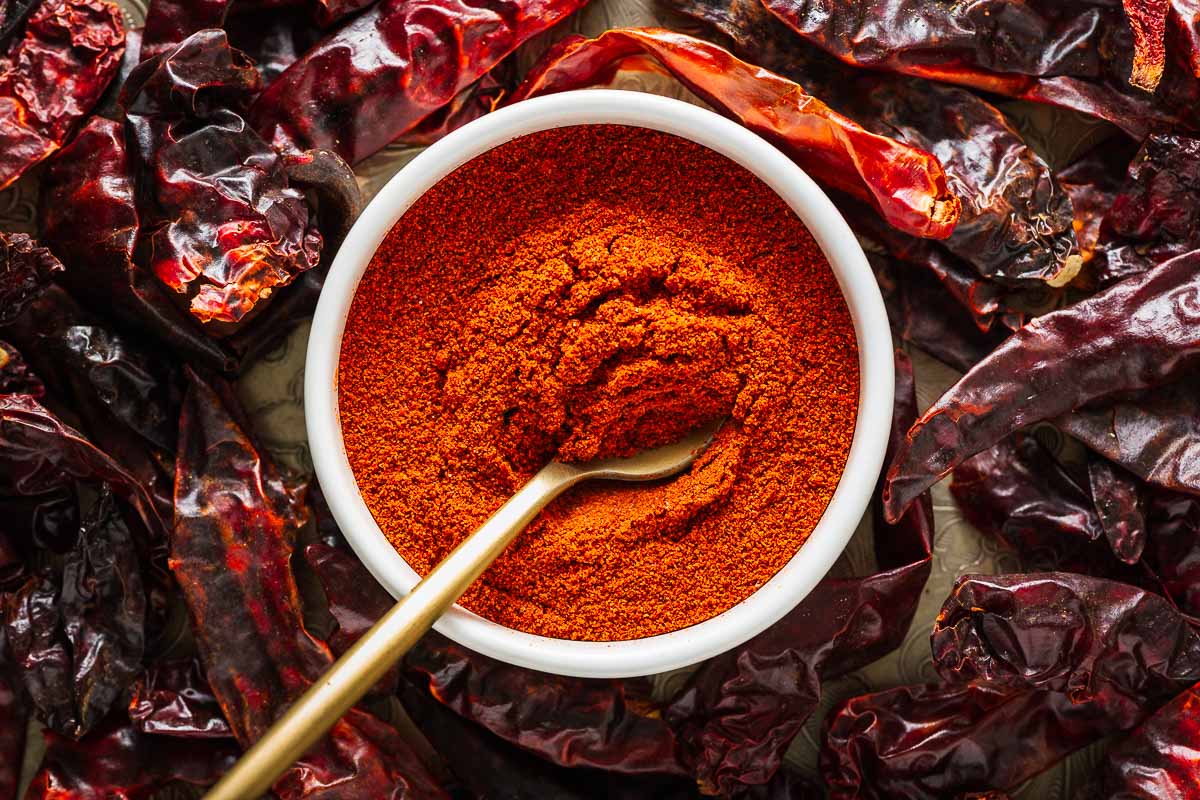
You can use cayenne pepper as a substitute for Aleppo pepper in recipes like falafel and tahini salad. But the risk of overpowering your dish is much greater when using cayenne pepper.
Start with a quarter teaspoon of cayenne pepper powder for every teaspoon of Aleppo pepper called for in your recipe. Then adjust it to taste.
Why not make homemade cayenne pepper powder?
10. Crushed red pepper flakes
Red pepper flakes can contain a mix of chile peppers, dried and then crushed into small pieces – most often with the seeds included.
Regular red pepper flakes can measure anywhere between 32,000 and 48,000 SHU – this is much spicier than Aleppo pepper! And the flakes definitely lack the complex flavour of pul biber.
I prefer to use seedless chilli flakes or powder as Aleppo substitutes. Contrary to popular belief, the seeds are not the spiciest part of the chilli. In fact, they contribute very little flavour to the red pepper flakes.
But, if red pepper flakes are all you have available, you can use it instead of Aleppo pepper flakes to add some heat to your dishes. Start with half the quantity of Aleppop pepper that the recipe requires. Then scale it to taste.
11. Spice blends
If you would like to replicate the complex flavour of Aleppo pepper without requiring an exact match, you can also play around with different hot spice blends.
Peri-peri spice mix (or piri piri powder) is a unique blend of spices originating from Mozambique. It has a smoky, slightly sweet and spicy flavour, making it a very creative substitute for Aleppo pepper.
Harissa powder is a fiery North African spice blend. It is rich and smoky with a delightfully spicy kick to any recipe. But it works especially well in Middle Eastern and Mediterranean dishes – just like Aleppo pepper.
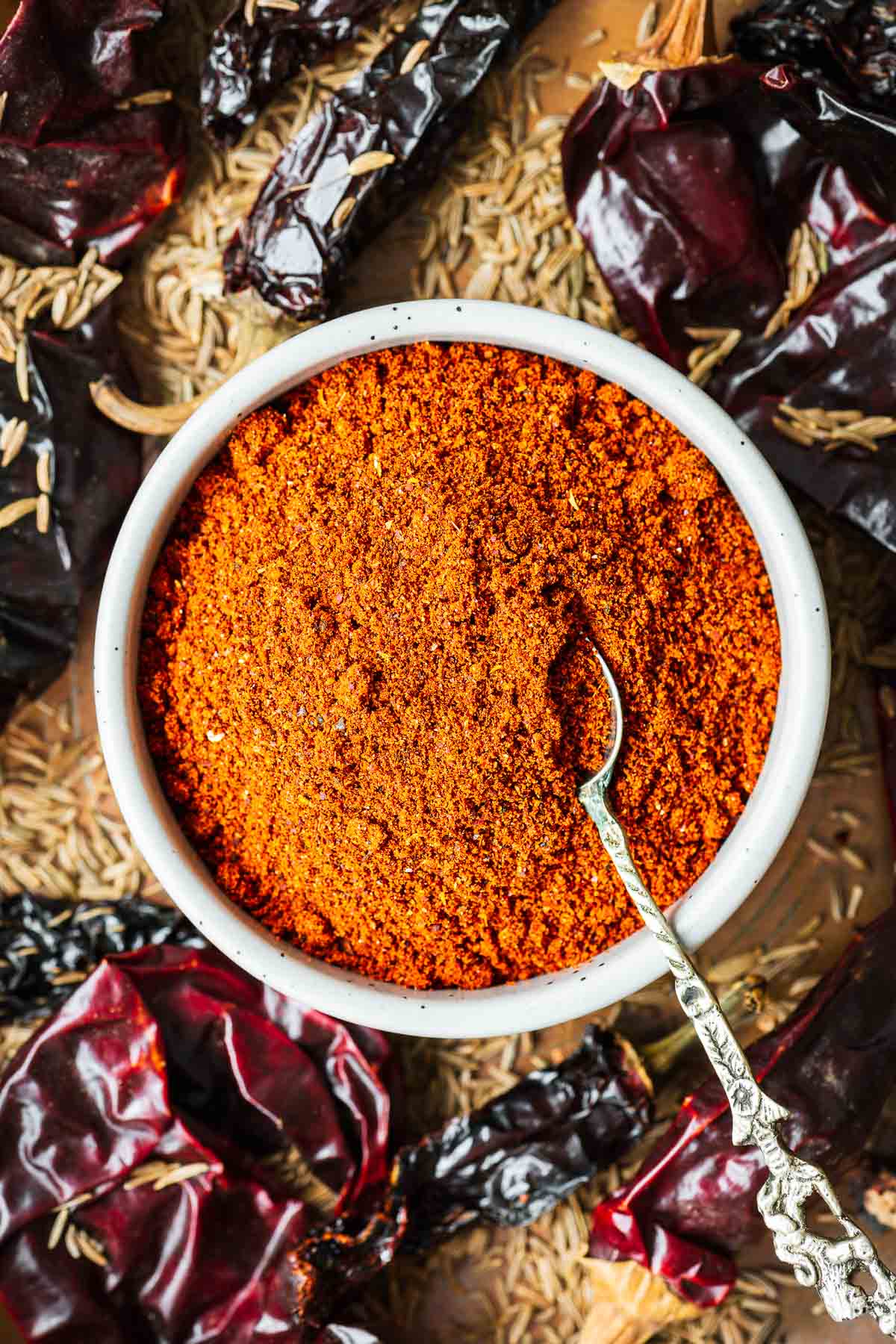
12. Hot sauce
And when all else fails, there is always hot sauce.
If you don’t have any suitable chile flakes to use instead of Aleppo pepper, why not grab that bottle of hot sauce? Or add a teaspoon of fragrant rose harissa paste for instant Middle Eastern flavour. It won’t have the same flavour as a teaspoon of Aleppo pepper, but I guarantee it will taste great.
This substitute will work in soups, stews and dips to add a spicy kick. But don’t use it in recipes where the moisture content of hot sauce can cause problems – like in falafel mixtures. Then it might be best to go for any of the chile powders listed above or leave it altogether.
How to use Aleppo pepper
Aleppo pepper flakes are a versatile and flavourful spice that adds a unique spicy flavour to your dishes. If you’re new to Aleppo pepper flakes or looking for inspiration on how to use your homemade Aleppo pepper substitute, this is the place to start:
- Sprinkle it on roasted vegetables: Enhance the natural sweetness of roasted vegetables by sprinkling Aleppo pepper flakes over them before or after cooking. The gentle heat and subtle sweet smokiness elevate any grilled veggies. Try it in these shawarma-style roasted cauliflower florets.
- Season grilled meats: Use Aleppo pepper flakes as a rub or marinade for grilled meats like chicken, beef, or lamb. Combine the flakes with olive oil, garlic, and dried herbs for a delicious and aromatic seasoning.
- Add it to soups and stews: Enhance the depth of flavour in soups and stews by adding Aleppo pepper flakes during the cooking process. The mild heat and fruity notes will infuse into the broth, creating a warm and inviting taste. Sprinkle it over this Persian eggplant stew for a zesty kick.
- Sprinkle it on egg or avocado toast: Elevate your toast game with a generous sprinkle of Aleppo pepper flakes. The combination of creamy avocado or runny egg yolk, toasty bread, and a hint of heat will take your breakfast to the next level.
- Mix it into salad dressings: Create a vibrant and flavourful salad dressing with Aleppo pepper flakes. Add it to this easy leftover hummus salad dressing instead of cayenne pepper for a milder heat.
- Experiment with Middle Eastern dishes: Aleppo pepper flakes are common in Middle Eastern cuisine. Add them to dishes like lemony hummus, baba ganoush, or spice blends like harissa powder or shawarma spice for a deliciously authentic touch.
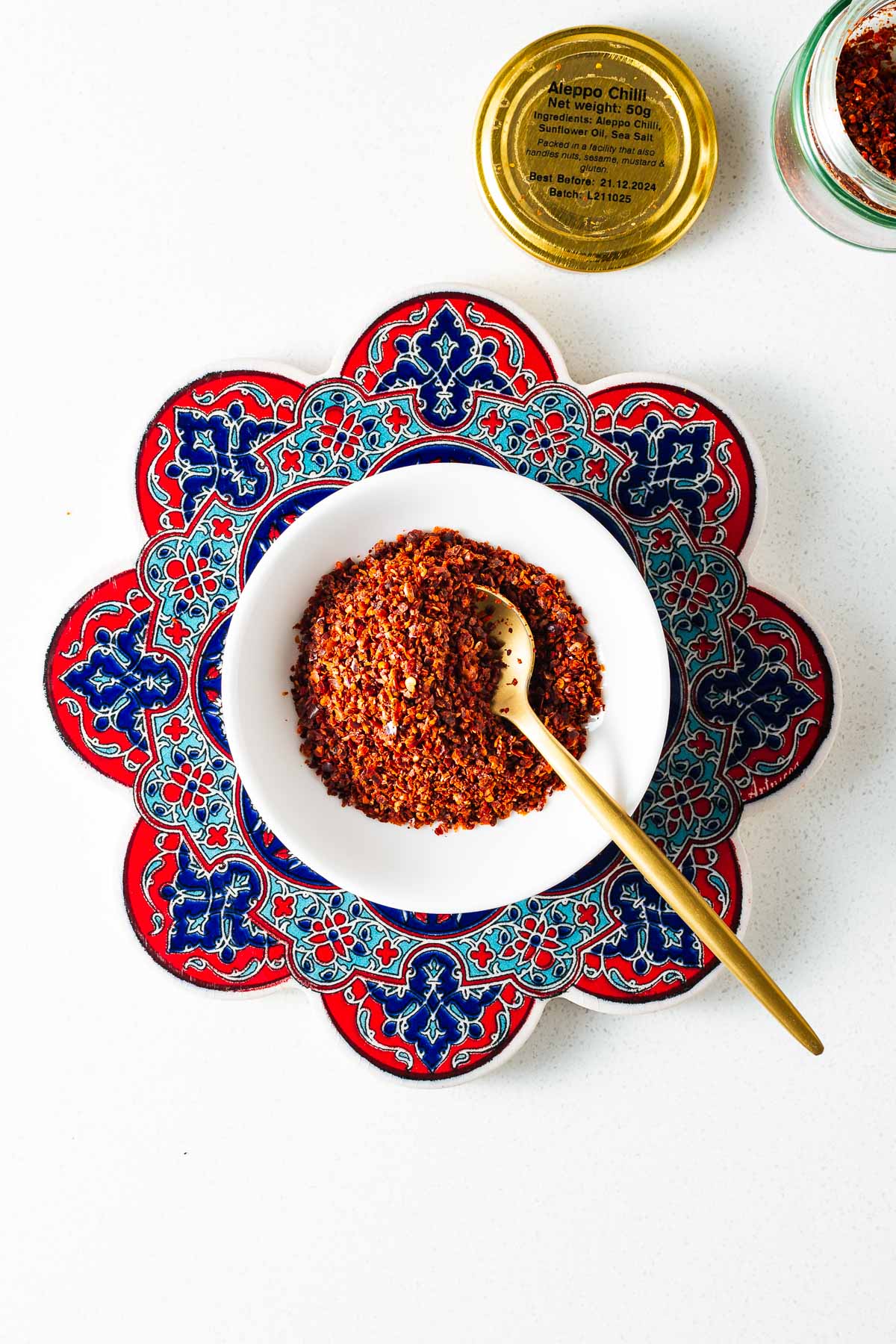
Frequently asked questions
Smoked paprika is a decent substitute for Aleppo pepper. It has a sweet red pepper flavour and a smoky taste, but it is less spicy than Aleppo pepper with a finer texture. Add a pinch of cayenne pepper for more heat and a small pinch of salt for savouriness.
Yes, you can use Aleppo pepper as a substitute for chilli powder. While chilli powder is a mix of spices, Aleppo pepper is coarsely ground Halaby peppers with some salt. It has a more intense red pepper flavour with earthy, smoky notes and moderate heat. But it makes a great substitute for chilli powder.
Aleppo pepper flakes have a naturally smoky and earthy, sweet red pepper flavour with a touch of savouriness. It has a mild to moderate level of heat.
No, Aleppo pepper is much milder than cayenne. Aleppo pepper measures about 10,000 Scoville heat units, while cayenne has a much higher heat level of 30,000 to 50,000 Scoville heat units.
Yes, Aleppo pepper is hotter than jalapeno. Aleppo pepper measures about 10,000 Scoville heat units, while jalapeno peppers have a heat level of 2,500 to 8,000 Scoville heat units.
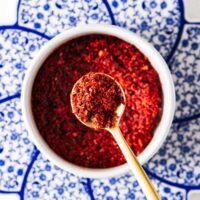
Ingredients
- 2 tablespoons gochugaru , or another seedless pepper flake
- ½ teaspoon sunflower oil , or another neutral-tasting oil
- ¼ teaspoon smoked paprika
- pinch ground cumin
- pinch sea salt
Instructions
- Place the chilli flakes in a small bowl and add the sunflower oil. Then use a spoon to stir and coat the chilli flakes with oil. Finally, stir in the smoked paprika, ground cumin and sea salt.
- The Aleppo pepper substitute is ready to use straight away. Or store it in a sealed container for up to one month.
Notes
- You can also use another type of chilli flake and adjust the spices. For example, if you use smoky chipotle flakes, you should omit the smoked paprika. And if your chilli flakes are very mild, add a pinch of cayenne pepper.
- See the full blog post for more Aleppo pepper substitutes, such as Marash biber, cayenne pepper, ancho chile powder, and more.
